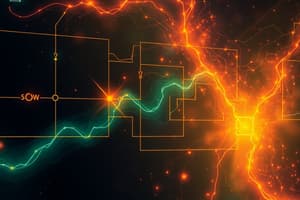Podcast
Questions and Answers
What does Kirchhoff's Voltage Law (KVL) state?
What does Kirchhoff's Voltage Law (KVL) state?
- The algebraic sum of voltages around any closed loop in a circuit is equal to zero. (correct)
- The algebraic sum of voltages around any open loop in a circuit is equal to zero.
- The voltage across a closed loop in an electric circuit is always a positive value.
- The voltage in a circuit loop can be anything but zero.
What does the algebraic sum of voltages around a loop represent according to KVL?
What does the algebraic sum of voltages around a loop represent according to KVL?
- It represents zero due to conservative electric fields. (correct)
- It represents the total current in the circuit.
- It represents the total energy dissipated in the circuit.
- It represents the total resistance in the circuit.
How are voltages represented when applying KVL to a circuit?
How are voltages represented when applying KVL to a circuit?
- As positive values regardless of direction.
- As positive values for clockwise direction and negative values for counterclockwise direction.
- As negative values for clockwise direction and positive values for counterclockwise direction. (correct)
- Only as negative values.
What is the practical implication of Kirchhoff's Voltage Law?
What is the practical implication of Kirchhoff's Voltage Law?
How is Kirchhoff's Voltage Law typically verified experimentally?
How is Kirchhoff's Voltage Law typically verified experimentally?
What happens if the algebraic sum of voltages around a closed loop does not equal zero?
What happens if the algebraic sum of voltages around a closed loop does not equal zero?
Flashcards are hidden until you start studying
Study Notes
Kirchhoff's Voltage Law (KVL)
Gustav Robert Kirchhoff's Voltage Law (KVL) is a fundamental principle that describes how the voltages in a closed loop in an electric circuit must add up to zero. This law is based on the concept that the electric field and electrostatic forces are conservative, meaning they return to their original state after performing a complete cycle.
Algebraic Sum of Voltages
According to KVL, the algebraic sum of voltages around any closed loop in a circuit is equal to zero. Mathematically, this can be represented as follows:
Σv = 0
where Σ represents the algebraic sum of voltages around the loop. The sum is positive if clockedwise and negative if counterclockwise.
Practical Implications
In practical terms, KVL helps in analyzing and designing electrical circuits. By applying KVL to a given circuit, one can derive equations that relate currents, voltages, and resistances, allowing for a better understanding of the behavior of the circuit.
Experimental Verification
KVL has been verified through experimental tests, such as the work documented in and. These experiments involved constructing simple resistive circuits and evaluating the sum of the voltage drops around different closed paths. The results showed that KVL held true, further supporting its significance in electrical circuit analysis.
Studying That Suits You
Use AI to generate personalized quizzes and flashcards to suit your learning preferences.




